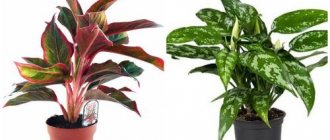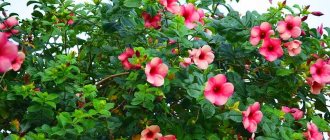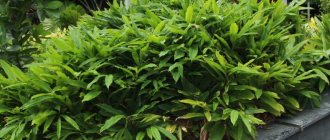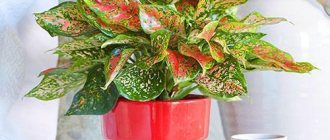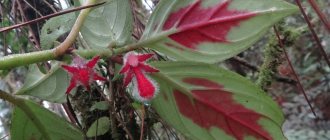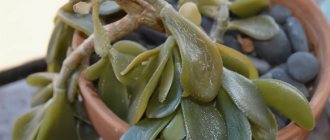A guest from the Asian southeast, aglaonema, despite its distribution in warm and humid India, Thailand, Vietnam and China, grows and develops well in home conditions. Today it is a popular indoor flower.
This plant first became known at the beginning of the eighteenth century in the Philippines. The name was given to the flower a century later by a botanist from Austria. It was formed from two Greek words: “aglos” - bright and “nema” - thread.
Appearance of aglaonema:
- it is a bushy flower with a smooth and straight trunk, from 30 to 80 cm in height;
- Aglaonema's foliage is dense and large, with long petioles;
- the color of the leaves differs in shades of green, with various veins of several colors;
- the plant has no more than 3 inflorescences resembling a cob;
- On the inflorescence you can see fruits, the red peel of which stands out very much against the background of the greenery of the plants.
Where to put an aglaonema flower
The home aglaonema flower should be placed according to whether the species loves light or prefers shade. Most species prefer shaded areas, so a window sill on the south side of the house is unlikely to be a comfortable place to grow them.
It is worth noting that varieties with red leaves tolerate the sun better than others; they love good lighting. The general rule is: if the foliage of the aglaonema is within the boundaries of a right angle (minimum 40 degrees), then the lighting for it is optimal. If the foliage drops lower, the lighting should be reduced slightly.
Growing aglaonema in summer requires some additional darkening; in winter, on the contrary, you need to add a little light.
Temperature
It is believed that the ideal temperature for growing aglaonema will be in the range from 20 to 25 degrees. The ideal would be 18 degrees Celsius. Although in winter, if there is a lack of watering, the flower can be left for short periods of time and at a temperature of about 10 degrees.
Sudden changes in temperature, as well as drafts, can be detrimental to this plant. Therefore, they cannot be allowed to occur. It is important to consider the humidity level, which should be high. To do this, you can spray the plant with a spray bottle, while simultaneously cleaning the foliage from accumulated dust.
If in summer aglaonema needs to be sprayed periodically, then during the season of active operation of heating systems, measures to moisten the room and plants in particular need to be strengthened. Placing a pot with a flower on a tray filled with water works well. Naturally, the pot itself should not touch the surface of the water. Occasionally, you can give your plants tropical rain in the shower.
8.Note
Do not grow this plant in homes where there are children and animals, as its juice and berries are poisonous .
After 3 - 4 years, the plant begins to lose its lower leaves, exposes the lower part of the shoots and becomes untidy - it needs to be renewed . Replace it with a young bush by cutting and rooting the top.
Aglaonema grows best in a tropical " flower window " with constant temperature and humidity.
These decorative leafy bushes are able to purify the indoor air from many harmful impurities - for example, formaldehyde and benzene.
From time to time you can notice small transparent droplets on the leaves - the plant seems to be “ crying ”. There is nothing wrong with this - it’s just that at this time the flower is kept in high air humidity or the weather outside is cloudy and rainy.
↑ Up,
Watering and fertilizing
Caring for aglaonema at home cannot be called very difficult; rather, it brings pleasant troubles, which are rewarded a hundredfold by the contemplation of a magnificent flower.
Watering aglaonema differs depending on the season:
- In spring and summer, when the active growing season begins, active watering and care of the plant is required. Irrigation with water is carried out as soon as the upper part of the substrate dries out.
- In autumn and winter, watering is carried out a little less often, with an interval of two days.
It is important to water the aglaonema only with water that has previously settled and is at room temperature. Do not over-dry or over-moisten the soil, as this can have a bad effect on the plant.
As for fertilizers, an important condition here is the absence of lime in any fertilizer complexes. You can care for the flower using fertilizers with potassium, nitrogen and other microelements.
It is very important to add fertilizer not only to the soil, but also by spraying it on the foliage, which will allow it to actively gain strength. The best time to fertilize is from spring (March) to late summer (August). This should be done twice a week, immediately after watering, at a time when the sun does not hit the flower. In winter, it is not recommended to feed the plant.
Description of the plant
Aglaonema is a genus of plants in the Araceae family, which includes 23 species native to tropical regions of Southeast Asia, from India to Papua New Guinea. Many years ago, Aglaonema came to us from the Asian tropical forests, where it grows in dense forests and protects its foliage from the scorching sun under the trees. It settled in easily with us and, thanks to its ability to adapt to more difficult lighting conditions, it grows even in the shadiest corners of the house, tolerates dimly lit positions well, but must be protected from direct contact with the sun.
The scientific name Aglaonema comes from the Greek words - αγλαός (aglaos - bright, beautiful) and νήμα (nema - nothing). The name refers to the structure of the plant's male flowers.
Aglaonema blooms from spring to late summer. The aglaonema flower is truly unusual, typical of representatives of the Araceae family, that is, similar to the flowers of spathiphyllum or anthurium. It is shaped like a spadix and is most often white, although some varieties have yellow flowers. The lower part of the cob is tightly “wrapped” with sepals. Over time, red or yellow fruits – berries – are formed from inconspicuous flowers.
All species have lanceolate leaves, which are usually quite decorative, which is why they are so popular. Leaves can have different colors.
Plant species
The genus Aglaonema includes 23 species, but only a few of them are grown in our country.
Popular types:
- Aglaonema commutatum is most often found indoors at home. Plants often have bicolor leaves, green with greyish patterns. Breeders have developed numerous varieties with interesting and varied colors of leaf blades.
- Aglaonema crispum - gray leaves with dark green edges.
- A. round (A. Rotundum) - green leaves with red veins.
- A. ribbed (A. Costantum) - the leaf is decorated with white veins.
The most popular potted plants are those with large decorative leaves. Among the most beautiful and frequently grown is the Variable Aglaonema (Aglaonema commutatum). This is a real gem among plants grown at home. Its cultivation will be discussed further.
Aglaonema crispum - description
In its natural environment, modified aglaonema forms a trunk and can reach a height of 2 meters. In apartments it rarely reaches 80 cm. It usually has a bush form - it consists of stems on which magnificent leaves appear. The leaves are borne on long petioles and grow on a tough, tall, unbranched stem, but they first form a beautiful tuft just above the ground.
The leaves are large, oval and elongated, rather thick and fleshy, slightly raised. They are slightly reminiscent of Dieffenbachia leaves, but are more attractive due to the decorative spots on both sides of the leaf blade. Aglaonema is very decorative precisely because of the silvery stripes that add attractiveness to the leaves.
Aglaonemas sometimes bloom in apartments; they produce a rather interesting inflorescence, which does not have any special decorative qualities. White or yellow flowers are inconspicuous, surrounded by green foliage, collected in flasks, completely odorless. Sometimes the plant bears fruit, producing red berries.
Photo. How aglaonema blooms at home
Attention! Aglaonema is highly poisonous. Its juice irritates the skin, so plants should remain out of the reach of children and cats. Poisoning can result in paralysis of the nervous system, and the risk of death is quite high. It should not be planted in herbivore terrariums.
Popular varieties
Aglaonema modified has been subjected to selection and received interesting varieties that cope better with home growing conditions. The latter options are most resistant to dry air, so central heating does not bother them.
The most popular varieties:
- "Silver Queen" Sliver Queen is the most popular variety with unusual leaves, almost entirely silver with green veins.
- “Crete” Crete is an aglaonema variety whose care should take into account varietal characteristics - red varieties are more demanding on lighting than green ones. Crete is a variety with variegated green leaf blades covered with intense pink-red spots, a pink-red rim and main vein. If there is not enough light, the leaves will turn green.
- "Fest Diamond" First Diamond is a variety with creamy green leaves.
- “Prestige” Prestige is green with numerous large pink spots.
- Aglaonema "Silver Bay" Silver Bay - green leaf blades with a large silvery-white spot in the center and light spots on the sides.
- "White Lance" White Lance - leaves are elongated, narrow, thin, with an elongated silver-white spot in the center and a green rim.
- "Bloody Mary" Blood Mary is a variety with intensely colored leaves of a dark red color and a small amount of green at the ends of the leaf blade.
- "Red Elephant" Red Elephant - the leaves are painted in an intense crimson-pink color, the green color is visible only in the form of irregular coloring of the edges of the leaf blade and sometimes in the middle.
- "Green Bowl" Green Bowl is a rare variety, has large leaves, concave, like gutters, and a very compact shape. The leaves are decorated with three shades of green.
- “White Kiwi” White Kiwi is a variety with small, tightly adjacent leaves, compact. Green edges and spots on creamy interior of leaves.
- "Butterfly" Butterfly - leaves are variegated, pink and green.
- "Anyamanee Tricolor" Anyamanee Tricolor - the leaves of the variety are large, oval, variegated, they look as if someone painted them green, red and yellow. The spots are irregular and of different sizes. Collection variety.
- "Amelia" is a variety with elongated leaves with white veins.
- "Anyamanee Red" Anyamanee Red is a variety with a bright pink leaf blade with decorative green-yellow spots.
- “Stripes” Stripes - the variety became popular after the release of the film “Leon the Killer”. A beauty with dark green large leaves and decorative silver-gray stripes.
Photo. Aglaonema variety Stripes in the film “Leon the Killer”
How to make aglaonema more bushy
Aglaonema does not grow at a very fast pace; in order for its foliage to develop efficiently and richly, it is important to keep the roots in a tight pot. The main thing is that there are holes in its bottom for ventilation.
The following tricks will help you make the plant bushy:
- Trimming shoots at a distance of 5 cm from the ground. The cuts should be sprinkled with coal dust.
- The cut shoots are rooted in water and then planted next to the main plant.
- To stimulate the growth of additional leaves, you can pinch the buds located on top.
2. Propagation of indoor plants
Throughout its life, the plant produces lateral shoots and basal suckers , which are used for vegetative propagation in spring or summer.
- Cuttings of aglaonema are best done in a special heated container, in vermiculite.
- Often cuttings take root even in a simple glass of water. You can even plant stems that have taken root and do not have leaves - they will begin to grow from the awakened lateral buds and will produce additional shoots from the buds that are located underground.
- Such stem cuttings should be placed horizontally, lightly sprinkled with moist soil - this will make the plant more lush, because leaves and roots will appear in each dormant bud.
- The successful completion of the rooting process will be indicated by the appearance of signs of new growth - young shoots.
Many varieties of Aglaonema are propagated by seeds and air layering . Seeds germinate in 25 - 30 days. For propagation, only freshly collected seeds are used.
Large adult specimens are propagated by division , which is carried out in the spring, during transplantation. The bushes are divided in such a way that each part ultimately receives its own, well-developed root system and green ground part.
↑ Up,
How to care for a plant at different times of the year
Aglaonema, like other plants, is sensitive to the seasons. Caring for this flower in different seasons is slightly different:
- Summer: This is the period when the plant actively blooms. It is necessary to replant the aglaonema into a larger pot with mandatory abundant watering and spraying. It is important to ensure that the air temperature remains at the same level. At this time, the plant is actively fed with fertilizers.
- In autumn: growth slows down, now you can reduce the intensity of watering. Bait feeding should be stopped at this time.
- In winter: a resting phase begins when it is enough to periodically spray the aglaonema with water in order to maintain a normal moisture balance. The air temperature must be reduced to 17 degrees so that the plant can rest.
- In spring: the time comes that is optimal for replanting a flower. Once every 5 years, the soil of mature plants changes and spring is the most suitable time for such a procedure. Be sure to wash the leaves from dust using water at room temperature and water the plant abundantly. Now is the time to apply fertilizing.
Caring for LA and LO hybrids at home
Once you plant a hybrid lily bulb on your site, you will receive a wonderful perennial miracle that will delight you for many years if you care for it properly.
Lighting
LA and LO hybrids are light-loving plants; they prefer well-lit areas, so they should be planted in sunny places, but light shading will not harm them to prevent sunburn on the foliage.
Temperature and humidity
In places where lily hybrid varieties are planted, moisture should not stagnate, as this leads to rotting of the bulb and infection with fungal diseases. Therefore, it is recommended to plant lilies in raised beds, having previously introduced drainage into them.
When growing lilies in a greenhouse, you need to ensure that the air humidity is always 65-85%.
If these conditions are not met, plants may drop buds and stop growing. To maintain constant humidity, you can set the ventilation system to a constant mode and ensure the necessary air circulation. When forming the root system of newly planted plants, the temperature should be maintained within 10-18 °C. After rooting - up to 25 degrees Celsius.
Watering, fertilizing, preparing for winter
Lilies need to be watered regularly, but weather conditions, the height of the plant and the degree of dryness of the soil should be taken into account. In cloudy weather, watering is reduced, and in sunny weather, the need for moisture increases.
It is recommended to fertilize lilies 3-4 times during spring, summer and autumn with the following types of fertilizers:
- After germination - complex mineral ones.
- When buds appear - phosphorus-potassium.
- At the beginning of flowering - potassium.
- After flowering - phosphorus-potassium.
All fertilizing is carried out after watering, having previously diluted with water. Before preparing for winter, LA and LO hybrids should be fed with phosphorus-potassium fertilizer for better subsequent wintering and the formation of flower buds.
Diseases and pests
To prevent the appearance of diseases or pest infestation, when purchasing an LA or LO hybrid, you must carefully inspect the bulbs. Before planting, they should be treated with Fundazol or a weak solution of potassium manganese. This will help avoid fusarium and onion rot. When leaves and stems are covered with brown spots, it is necessary to use antifungal drugs: Fitosporin or Bordeaux mixture.
Dangerous pests include the lily beetle, which destroys leaves and flower buds. These pests are noticeable on plants due to their red color. To combat them, as well as against aphids and flies, Karbofos, Actellik, Fitoverm are used. Fly eater, Thunder, Grizzly will help with damage to bulbs by mole crickets and wireworms.
It will also be interesting: Lily Longiflorum (Lankon, Dolcetto, Miyabi) - caring for long-flowered plants
How to transplant aglaonema correctly
Replanting aglaonema has its own significance; a flowering stem will not long please with green foliage in a pot that is too cramped. Moreover, young plants are replanted annually, due to the speed of their growth, and mature ones - a little less often. The following principles for replanting this plant can be noted:
- Soil: the substrate should be crumbly, as for heather or azalea. A mixture of humus, sand and charcoal mixed with soil is perfect.
- Pot: a young plant needs a diameter of 12 cm, and a mature one about 18 cm. It should not be too deep.
- Drainage is required; you can add some pebbles to the soil.
- Time: the greatest benefit from replanting is achieved if it is carried out at the very beginning of spring. At the same time, you can divide the bush into shoots and plant them separately to increase bushiness.
- After replanting, 3 weeks later, you need to fertilize the soil in the pots. This can be done using the following means: “Lignohumate”; "Agricola"; "Effecton".
Diseases and pests of aglaonema
Aglaonema, like other indoor plants, is susceptible to diseases and pests, which require timely control to prevent the death of the flower.
Table: errors in care and their elimination
| Problems | Causes | Elimination |
| The tips of the leaves dry out | The air in the room may be very dry. | Spraying foliage with warm water |
| The leaves curl and develop brownish rims. | Periodic drafts and unstable air temperature | Eliminate drafts, move the pot with the plant away from the window |
| Whitish spots appear on the foliage | Sunburn | Hide the plant from direct sunlight, after a while spray with warm water |
| The plant stops growing, the leaves turn brown | Watering with cold and hard water | Watering with water, which must settle for 1–2 days |
| Droplets of liquid collect on the leaves | Excessive watering, excess nitrogen in the soil | Remove nitrogen-containing fertilizers and ensure regular watering |
| The leaf begins to turn yellow | The plant is watered too often, air temperature is low | Adjust the temperature or move the plant to another room, control the intensity and frequency of watering |
| Foliage loses color brightness | The flower is in the shade, lack of microelements | Preventing illness, feed the flower. Add artificial correct light |
| The flower doesn't grow | The pot is too big | Change the pot to a smaller one |
Table: diseases and pests of aglaonema
| Diseases and pests | Signs of infection | Causes | Treatment options |
| Rust | Rusty spots on the underside of the foliage | Fungus and lack of air movement in the room | Remove diseased leaves and organize ventilation. Treat the plant with Mancozeb |
| Leaf spot | Brown spots on leaves that gradually begin to become wet | Fungus or overwatering | Optimize watering, remove affected foliage. Carry out fungicidal treatment |
| Stem rot | The stems of the plant begin to rot | The soil is too moist, the air in the room is stagnant | It is better to get rid of the diseased plant |
| Blackleg | Darkening of the cuttings | Due to too wet and dense soil | Throw away the infected cuttings |
| Mealybug | A coating resembling cotton wool appears on the leaves | Indoor air is too dry | 1. Remove the flower from other plants. Remove or treat all contaminated parts. 2. Application of insecticides (“Commander” or “Fitoverm”). 3. After a week, repeat the treatment to destroy the larvae. |
| Aphid | Small insects are visible on the shoots | Appears due to contaminated soil or plant | Application of insecticides: Bankol or Akarin. |
| Whitefly | White dots on leaves, their deformation | The use of neonicotinoids, as well as Iskra, Intavir, with their obligatory alternation. |
Varieties
Currently, several types of aglaonema are recommended for cultivation in home floriculture. Let's take a closer look at their most popular representatives:
Moderate
Another name is Modest. The plant is native to the Malay Archipelago, with some varieties found in southern Indochina.
Aglaonema moderate
This is a plant of medium height, a strand of 40-50 cm with a weakly defined central trunk. The trunk has weak branching; usually the leaves grow as if from one point. Even if you look closely, it is difficult to determine which leaf formed first.
Flower of aglaonema moderate with set fruits
It has oval, slightly elongated leaves with a pointed end. The leaves are green or dark green in color. The leaf size is average - about 17-20 cm in length and 6-10 cm in width . The leaves show several paired veins receding from the central one.
Type of plant with proper care plant
The fruits of the plant are green during ripening, and in the last month before ripening they turn red. Outwardly, they look like dogwood fruit.
Changed
This plant grows wild in the Philippine Islands and the Malay Archipelago. It has upright growing stems, the height of which depends on the growing conditions of a particular specimen. The stems are either 20 cm in height or 1.5 m.
Aglaonema modified (or changeable). Thick stem visible
The leaves of the plant are large - up to 30 cm in length and 10-12 cm in width. The color of the leaves can be varied. The leaves are rarely monochromatic, most often they are variegated, and there are both pieces of “variegation” of red and white pigments on a predominant green background, and vice versa – individual fragments of green on a common white or red.
Aglaonema variable with a predominance of white pigment
The petioles of the leaves are long and very strong. The flowering parts of the plant are collected in inflorescences of 2-6 pieces, while the spadix is relatively small and thin.
The length of the cob is usually 5-6 cm, while the length of the spathe is 7-8 cm, that is, the flower is almost completely covered from external influences. The fruits are bright red, giving the plant an additional decorative appearance.
Brilliant
Originates from Thailand or Sumatra. In the wild, it prefers damp forests or lowland plains. The plant is tall - stems and leaves can reach a height of up to 1 m. The color of the leaves is replete with shades of green.
Aglaonema splendor
The plant got its name from the shiny upper part of the leaves. Their sizes are quite large: length up to 50 cm, width up to 20 cm. Flowers are collected in inflorescences of 2-5 pieces. The cob is completely covered with a blanket and is practically invisible. The fruits ripen by March. Their color is bright white.
The plant requires special care because it needs diffused sunlight. On the other hand, its size is quite large, so flower growers recommend devoting one of the entire windows to Aglaonema lucidum . Moreover, the gardener should not be embarrassed by the small growth of the plant: with proper care, in 2-3 years it will occupy the entire area in front of this window.
Ribbed
Originates from South West Malaysia. It is a herbaceous plant with a low stem, abundantly branched at the base.
Aglaonema ribbed
The leaves are oblong, pointed at the end. Their length reaches 20-25 cm, width 5-10 cm. They are quite strong, one might say, rigid. The color is almost always dark green with many white streaks and spots located on top. The lower part of the leaf partially repeats the color of the upper part, but there are significantly fewer spots.
Painted
This plant is native to the jungles of Sumatra and Borneo. The plant is medium in size, its height rarely exceeds 60 cm. It has a weakly defined “trunk”, strongly branched from below. The shoots are densely covered with leaves. The color of this aglaonema is a very characteristic three-color, reminiscent of some types of military camouflage.
Aglaonema painted
The leaves are small, about 10-18 cm long and 5-6 cm wide. Pigment spots are distributed evenly across the leaf, but the intensity of the color depends on the place where the plant lives. In more illuminated areas, the colors are more faded, in shaded areas they are brighter.
Aglaonema painted with elongated leaves
The fruits of the plant are located, as a rule, on stems raised above the leaf mass by 5-6 cm. They are bright red, very decorative and clearly visible from afar.
Oblong
Another name is oblong-leaved. Comes from the Philippine Islands. It has green or white-green oblong leaves. Their length is about 30 cm, and their width is no more than 5 cm. The petioles of the plant are also long, about 20-25 cm.
Aglaonema oblongata
It has the most elongated leaves (in relative proportions) , which, taking into account the length of the petiole, creates the illusion of very long shoots, which is often used in design.
Usually, a pot with Aglaonema oblongata is placed on a separate stand to enhance the effect.
Methods of propagation of aglaonema
This plant can be propagated by all popular methods, including using seeds, cuttings and planting rhizomes.
Propagation by seeds
The easiest way to propagate aglaonema is through seeds; it is not too labor-intensive. This method allows you to obtain all the characteristics of the mother plant, and, therefore, perfectly adapt them to the surrounding space; the flowers will not experience difficulties with acclimatization. However, there is always a risk of producing foliage different from the parent.
You can propagate by seeds like this:
- during the formation of fruits on an adult plant, there is no need to remove them until they are fully ripe;
- when the fruits turn red, they can be removed (they should remain in the hand when touched);
- The plant should be propagated in the spring by planting seeds in light soil and covering with polyethylene;
- You need to water the plants little by little, but often enough;
- The secret of seed germination is to plant them immediately after harvesting, because they quickly lose their quality.
Cuttings
Aglaonema can be replanted by separating cuttings. This type of propagation allows you to grow a strong plant in a short time.
The cutting process goes like this:
- cuttings must be separated before the plant begins to bloom;
- A stem with branches is perfect for this purpose;
- The cut areas must be sprinkled with coal dust;
- the cutting must dry for 24 hours;
- it needs to be rooted in a previously prepared sand-peat substrate;
- the cuttings are planted in moist soil to a depth of 5 cm;
- The seedling should be covered with polyethylene and left for 3 weeks at an air temperature of 25 degrees.
Using rhizomes
Aglaonema can be propagated by dividing its rhizomes; a plant that has grown too much and has produced many young shoots is suitable for this purpose. They are the ones that are used when choosing this method.
By division, you need to plant those shoots that are sufficiently developed, have strong foliage and healthy strong roots. Seedlings must be carefully separated from the adult plant, divided into pots and carefully planted in the ground. Deepening it by 5–6 cm. After which you need to water the plant abundantly.
To help root aglaonema, you can cover the seedlings with polyethylene or a glass jar, creating the effect of a greenhouse with high humidity underneath. Regular watering and spraying will help the plant actively develop and grow quickly.
Care
Selecting a location, temperature and lighting
Since the plant comes from the tropics, all the standards necessary for growing tropical crops can be applied to it:
- they need warmth
- they prefer high humidity
- don't like drafts
- do not like direct sunlight
Aglaonema prefers shaded space and diffused lighting
Direct sunlight is harmful to her. Based on this, we can say that the plant will feel great on northern, eastern or western windows. Or somewhere in the center of your home or office.
Great decoration for the office
Even that small part of the artificial lighting that will be inside will be sufficient for the normal growth and development of the plant with its slow metabolism.
Aglaonema on the northern windowsill
On the other hand, you need to focus on the number of green areas on the leaves. Chloroplasts, which provide the flower with carbohydrates, are found only in them. Therefore, plants with completely green leaves can be installed in any light conditions, and those in which green areas actively alternate with non-green ones are best placed near sources of diffused light.
Aglaonema Silver Queen with few green areas on leaves
The temperature regime for the plant must be maintained with sufficient severity. In summer, the temperature ranges from +22°C to +25°C; Some heat-loving species require even higher values (+25...+28°C). In this case, it is undesirable to exceed the temperature above +30°C, since the plant may begin to wither.
In winter, temperatures are slightly lower (usually by 2-3°C).
The recommended temperature “window” is +20…+22°C. The lower temperature limit below which the plant dies is +15°C.
Like all tropical plants, aglaonema does not like daily temperature changes of more than 7°C. Therefore, if in the summer there is a desire to place the plant in the garden in the open air, you should find out in advance the temperature forecast for the near future so that the plant does not suffer from a cold snap at night.
Here, an important role is played not only by the temperature value itself (since it can be within acceptable limits), but also by its change over a short time. With such fluctuations, the flower may lose leaves. First they wither and then fall off.
Drafts are dangerous for plants precisely due to the creation of temperature gradients of 5-7°C, when, in a seemingly warm room, a narrow wind flow creates an area with a temperature several degrees lower than room temperature. Therefore, you should not place pots with plants in places where there are likely to be drafts.
Soil and container
The main requirement for the soil for this plant is lightness and looseness of the soil, as well as its ability not to accumulate, but to pass moisture. Like all Araceae, Aglaonema can grow even on practically infertile soils; It is even fashionable to grow it without a substrate - only in water or using hydroponics.
However, for the gardener it is simpler and calmer when the flower “sits” in a pot.
Soil and pots
The plant prefers neutral or slightly acidic soils . It is also possible to use slightly alkaline soils with the addition of a small (no more than 25%) amount of peat. Let's look at recipes for substrates that can be used for normal cultivation of aglaonema at home.
The classic scheme of a substrate with neutral or very slightly acidic acidity is as follows:
- leaf soil - 2 parts
- peat – 1 part
- coarse river sand – 1 part
You can slightly change the living conditions of the plant, increasing the fertility of the soil, but slightly reducing its looseness.
The composition will be as follows:
- leaf soil - 1 part
- turf soil – 1 part
- peat – 1.25 parts
- sand - 2 parts
If the owner believes that the plant simply needs rich soil, you can use the following recipe:
- leaf soil - 3 parts
- peat – 2 parts
- humus or compost – 1 part
- river sand – 1 part
The soil can be changed at each transplant. And it is done quite often: a young plant (up to 3 years old) is replanted once a year, then once every 2 years, 3 years, and so on. Thus, in 10 years, aglaonema can be replanted up to 6-8 times.
With such a number of transplants, it is possible to select the optimal substrate for the specific specimen that is available in 2-3 years. The container for the plant should be given special attention: the root system of Aglaonema is fibrous, which means it is distributed over the surface, without significant depressions characteristic of the rod system.
Therefore, for Aglaonema, deep pots are not only undesirable, they are meaningless. Aglaonema begins normal vegetation and flowering when the roots fill the entire space of the pot. Therefore, it is necessary to use a wide and shallow pot.
Plastic pot for aglaonema
But the main thing here is also to maintain the “golden mean”; A pot that is too shallow is also undesirable, since about a third of its height will be occupied by perlite or expanded clay drainage.
Watering and spraying
The plant has two distinct periods of life: summer and winter. The summer period is the growing season, it lasts from March to August; winter is the formation of fruits and dormancy (from September to February). Each period differs in the speed of metabolic processes and requires a different amount of water to maintain them.
As such, the plant does not have a time limit for watering, since it depends on various conditions:
- illumination
- air humidity
- moisture capacity of the substrate
- temperature
Each of them has its own effect on the frequency of watering. For example, a flower standing in the shade requires less frequent watering than one in the sun. The criterion for starting watering is a completely dry top layer of soil.
The plant does not tolerate drought well, so it is necessary to monitor the condition of the soil daily. On average, in summer, watering is done weekly.
Watering flowers
It is necessary to water until the top layer of soil is completely moistened. Water for watering aglaonema must meet certain criteria; it should either be left standing for a week or boiled. This will allow the chlorine to completely leave it and get rid of the salts it contains.
These salts can concentrate in the top layer of the substrate and it becomes covered with a sort of whitish coating, after which you have to completely change the soil in the pot. In addition, the water should be 2-3°C above room temperature.
You can indirectly determine the quality of watering by the appearance of the plant: if the leaves dry out, become limp and wrinkled, then the volume of watering or their frequency needs to be increased. If the leaves turn yellow or spots appear on them, then perhaps there are harmful impurities in the water, or it is not settled enough and there is chlorine left in it.
On the other hand, excessive waterlogging is also contraindicated for the plant. After watering, it is necessary to drain the water from the tray of the pot and regularly inspect the upper part of the root system of the plant in order to track the first signs of rot. If the top layer of the substrate does not dry out for a long time, the intensity of watering should be reduced.
In winter, the frequency of watering and the amount of water applied to the plant are reduced. It is recommended that the plant receive 3 times less water per month than in the summer. That is, if in winter you increase the interval between waterings by 2 times, then the amount of water applied decreases by 1.5 times.
The plant loves high air humidity, so its leaves are sprayed every day. Sometimes it is recommended to do this twice a day. In this case, the same water is used as for irrigation: also well-settled (or boiled) and at the same temperature (2...3°C above room temperature).
It is necessary to leave droplets of moisture on the leaves; wiping them with any rags or sponges is prohibited. In winter, the plant is sprayed once every two weeks.
Feeding
The plant needs fertilizer throughout the year. At the same time, in summer, fertilizing is applied once every 2 weeks, in winter - once every 5-6 weeks. It should be noted that in winter, the dose of a single application remains the same as in summer, only the time between fertilizer applications changes.
Plant nutrition
Any balanced fertilizer for flowering indoor plants is used as a fertilizer. This could be “Mr. Color”, “Fertimix” and similar compositions. It is advisable to combine the application of fertilizers with watering the plant.
Transfer
This procedure is one of the key ones, since its beautiful appearance, speed of vegetation and normal flowering depend on the health and degree of development of the plant’s root system.
Normal leaf growth, inflorescence formation and flowering itself occur only in plants that have a fully formed root system. The word “formed” means one that occupies the entire available volume of the pot.
Transplantation process
It is best to replant plants in the spring. In this case, you can get by by replacing the top layer of soil (up to 2-3 cm deep) with a new one. But many gardeners recommend a complete transplant. Young plants are replanted every year for 3 years, plants from 3 to 6 years old are replanted once every 2 years, plants older than 6 years - once every 3 years.
The transplant is carried out as follows:
- The plant is removed from the pot along with a lump of old substrate, the lump is completely destroyed, and the roots are carefully cleaned.
- The new pot is taken 2-3 cm larger in diameter than the previous one.
- A layer of drainage is placed at the bottom of the new pot, with a depth of a quarter to a third of the height of the pot. Either expanded clay, small pebbles, or perlite are used as drainage.
- New substrate is poured up to half of the remaining volume.
- The plant is placed in the pot, the substrate is added and it is lightly compacted.
- The plant is watered abundantly.
Reproduction
Like all indoor plants, the most optimal methods for propagating aglaonema are vegetative propagation methods. This may be cuttings or dividing the bush.
Sprouted cuttings of aglaonema
Cuttings
Produced as follows:
- The upper part of the shoot is cut off from the stem.
- The cut is treated with charcoal or activated carbon.
- The cutting is planted in a moistened substrate to a depth of 4-6 cm. Substrate composition: peat and sand in equal proportions.
- The pot with the substrate and cuttings is placed in greenhouse conditions or simply sealed with polyethylene or a glass jar on top.
- The cuttings in the pot are placed in a warm place. Rooting occurs in about a month.
- Then the cuttings are planted in the usual substrate used for transplantation.
Dividing the bush
Produced during transplantation. The root system of the mother plant is divided using a garden knife, cutter or pruner. At the same time, the cut areas of the root and stem parts are treated with charcoal.
Dividing an aglaonema bush during transplantation
Then each of the new plants is transplanted into its own individual pot and placed in a dark place for one week; this is necessary for their rooting. The first watering of transplanted plants is allowed only on the 8-9th day.
Seed propagation
Aglaonema is one of the few indoor tropical plants whose seed propagation can be used more or less successfully. However, one should take into account the fact that seed germination (although initially very high, up to 80%), quickly decreases over time. It is believed that after 2 weeks, half of the seeds lose their viability irrevocably.
In order not to miss the moment and to get as many plants as possible, planting seeds for germination should be done as quickly as possible after collecting them.
You need to be sure that the seeds are ripe (usually 7 months of ripening is enough) and then collect them. Moreover, the collection must be carried out in all fruits at the same time.
Immediately after extraction from the pulp, the seeds are washed and they are planted in the same soil that is used for cuttings (peat and sand in a ratio of 1 to 1). It is advisable to place the seeds in containers 8-10 cm deep, covered with transparent glass in a sunny and warm place.
Sprouted Aglaonema seed
Once a day, water the seeds and aerate the soil for 3-5 minutes. The first shoots peck within a week. When 2 true leaves appear on the seedlings, they are picked and transplanted into individual containers. This can be either a larger container in which the plants are planted in a checkerboard pattern at intervals of 15 by 15 cm, or a small pot with a diameter of about 8-10 cm.
As soon as the plant is strong enough and has 3-4 leaves, it is transplanted into a stationary pot.
A young plant ready to be transplanted into a stationary pot
Since the plant is dioecious, you can select aglaonema at home, however, you shouldn’t delude yourself too much, since the plant’s variability can manifest itself in the most unpredictable forms.
Toxicity of Aglaonema
Aglaonema, which belongs to the aroid family, like most of its other representatives, is poisonous. This plant is considered dangerous to human health. However, it's not all that scary. For full poisoning, you need to eat several leaves, which an adult is unlikely to do.
Precautionary measures:
- the plant should be kept away from children, especially during the ripening period of the fruits, which have a very attractive color;
- When working with aglaonema, you need to beware of the juice that may be released (for this you need to wear gloves, watch the tools that are used), and not allow it to get on the mucous membranes of the body.
In general, the plant does not pose a great danger; it is important to be careful about its placement, closely monitor children and teach them safety precautions. After this, all that remains is to enjoy the appearance of the aglaonema, its picturesque, lush leaves and bright colors.
